Although quantum processors exist today, they are still a long way off from becoming practical replacements for classical computers. This is due to many practical considerations, not the least of which are factors such as the need for cryogenic cooling and external noise affecting the system necessitating a level of error-correction which does not exist yet. To somewhat work around these limitations, IBM has now pitched the idea of a hybrid quantum-classical computer (marketed as ‘quantum-centric supercomputing’), which as the name suggests combines the strengths of both to create a classical system with what is effectively a quantum co-processor.
IBM readily admits that nobody has yet demonstrated quantum advantage, i.e. that a quantum computer is actually better at tasks than a classical computer, but they figure that by aiming for quantum utility (i.e. co-processor level), it could conceivably accelerate certain tasks for a classical computer much like how a graphics processing unit (GPU) is used to offload everything from rendering graphics to massively parallel computing tasks courtesy of its beefy vector processing capacity. IBM’s System Two is purported to demonstrate this when it releases.
What the outcome here will be is hard to say, as the referenced 2023 quantum utility demonstration paper involving an Ising model was repeatedly destroyed by classical computers and even trolled by a Commodore 64-based version. Thus, at the very least IBM’s new quantum utility focus ought to keep providing us with more popcorn moments like those, and maybe a usable quantum system will roll out by the 2030s if IBM’s projected timeline holds up.



















